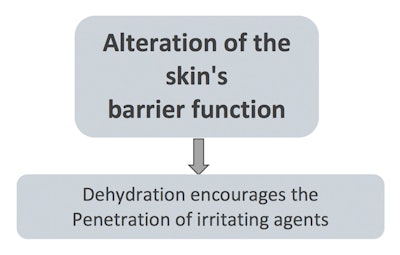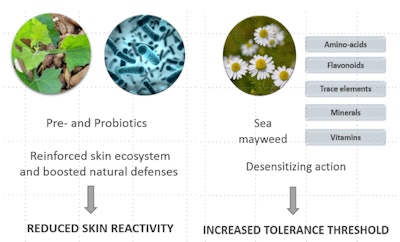
The Importance of a Healthy Skin Barrier
Spa-goers with sensitive skin typically present with a combination of a worn and compromised barrier function that sets the stage for dehydration and dullness, which can also range from mild to severe. The weakened barrier is usually the result of a combination of internal, external and psychological factors. Genetics, hormonal fluctuations, stress, deficient diet, U.V. damage, weather extremes, cosmetic ingredient reactions and lifestyle are all potential triggers for damaging the effectiveness of the skin’s barrier and its ability to guard the skin from opportunistic pathogens and irritants. This skin protection system becomes deficient and leads to transepidermal water loss (TWEL/dehydration) and reduced lipids (dryness), which in turn encourages the penetration of potentially irritating agents past the skin’s surface.

Solutions for Sensitive, Aging Skin?
Developing an Effective Treatment
Considering that at least 50 percent of clients with sensitive skin are also seeking solutions for age management, the professional skincare therapist will need to devise a two-part treatment program that will reverse the sensitivity prior to adding an advanced anti-aging care component. Only when the skin becomes rebalanced, resilient and stronger will professional strength antiaging peels be added into the regime, enabling their youth-enhancing effects to blend into a skin-strengthening program.
The Role of the Microbiota—The Skin’s Immunity & Protection
The epidermis is equipped with immune competent cells and mechanisms; and healthy skin is also teeming with friendly bacteria called the microbiota, a group of microorganisms that cover the human body. A first line of defense, the microbiota protects the deeper layers from invading pathogens and irritants. It alerts the organism and stimulates skins defense mechanisms.
Skin is perfectly protected if its eco flora is present in sufficient concentrations (here represented by +++). However, it gets weaker with every aggression, and is replaced by an opportunistic and pathogenic flora (represented here by the —). This flora causes skin imbalance that will lead to tingling, tautness and sources of discomfort.

When treating mature skin with significant sensitivity, the first phase of care should emphasize treatments that will rebuild the microbiome and barrier repair and restore healthy hydration levels that were lost due to the skin’s compromised barrier via TEWL. When the barrier and microbiome are protected, painful skin reactions and accompanying redness is controlled.
Pre- and Probiotics—A Sensibiotic Complex
Prebiotics are nutrients that favor the development and upkeep of the skin’s microbiota. They help nourish the skin’s healthy bacteria, protecting the skin from the growth of harmful bacteria that can lead to a host of skin imbalances. These ingredients will effectively rebalance the skin’s health and functioning as you transition the program into an anti-aging phase.
Launched in February 2018, and part of the Specifics phytoceuticals range of products, is the new Sensitive Crème from Laboratoires Multaler. Sensitive Crème contains prebiotic oligosaccharides drawn from the juice of yacon roots (also known as plant-based Inca honey) which contains bio specific nutrients that boost the development of the skin’s friendly bacteria.
Also, part of Yon-Ka’s Sensibiotic Complex are probiotics that have been sourced from two strains of lactobacillus (lactic bacteria) which undergo a gentle sterilization and freeze-drying process for optimum control. These bacteria maintain their unique “footprint,” which enables them to consume nutrients within their environment. They then convert to lactic acid, which helps eliminate the proliferation of targeted, unhealthy bacteria on the skin’s surface.
Sea mayweed has excellent desensitizing and ant-inflammatory effects, so with consistent use will strengthen the skin’s tolerance threshold. Shea butter, vegetable glycerin and olive phytosqualane work in tandem to restore the integrity of the skin’s barrier functions.

Age Management Phase—Selecting the Right Professional Peel
For the spa-goer with sensitive, aging skin it’s important that the skincare therapist educate them about how treating their sensitivity will simultaneously provide a potent anti-aging effect. This is because chronic inflammation has a significant effect on the skin’s aging process. Remind your clients that treating sensitivity and inflammation successfully is also an essential step for maintaining youthful skin tone and density.
It’s not until the sensitivity and inflammation begins to improve following their customized salon and homecare regimen that you can start to add professional strength peels that will help to refine the texture and appearance, yet not agitate the epidermis back into its inflamed state.
Choosing strong and highly caustic (strong mono glycolic acid, TCA peels etc.) peel should be avoided because they can easily undo the skin’s healthy resistance and focal point during the first phase of care.
At this stage of the treatment course the professional peel should contain a synergy of AHAs and BHAs, which will be effective at improving wrinkles, hyperpigmentation spots and mild skin atrophy. With their unique capacity to exfoliate at different layers of the epidermis, a synergy of lactic, mandelic and salicylic acids blended with apple cider vinegar and extracts is recommended for and well tolerated by sensitive, aging skin. Another effective peeling that is well suited for moderately sensitive skin blends glycolic and salicylic acids with vitamin C and brown algae. As you become more familiar with both formulas it may be appropriate to alternate these formulas and tailor the professional peeling to the unique needs of each client.
As the ebb and flow of life can affect sensitive and aging skin in both positive and negative ways, clients with these special needs must use gentle and effective products designed to promote a healthy barrier function, and make the skin more resilient and comfortable throughout their entire life. The advice that the professional esthetician provides on blending the needs of sensitive skin as it ages is crucial to its care and lasting good health.
For more information about sensitive skin, watch the video below.











